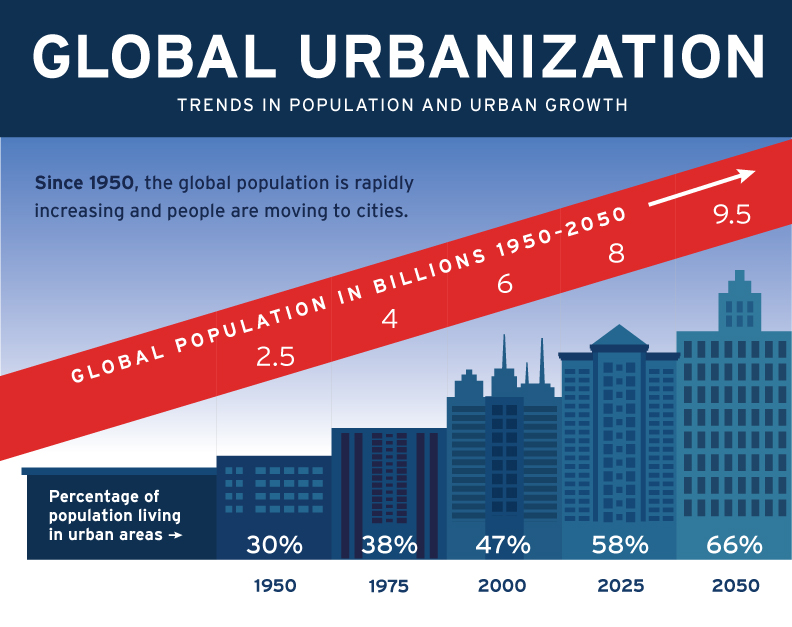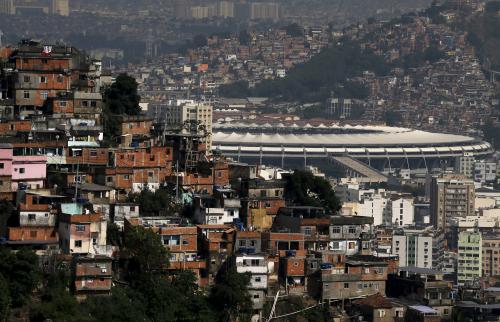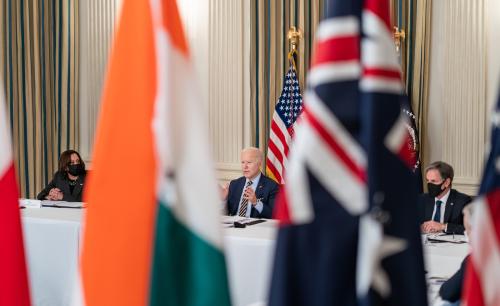This report is made possible by JPMorgan Chase, and is part of the Global Cities Initiative: A Joint Project of Brookings and JPMorgan Chase. The views expressed in this report are those of the authors and do not represent the views of the donors, their officers, or employees.
Today, more than half of the world’s population lives in cities. Over the next 30 years, that figure will likely increase to 66 percent.1 This breakneck pace of urban development, coupled with globalization and increased access to information, is changing geopolitics and global economic development.

Increasingly, cities are at the center of the world’s economic activity. In the United States, for example, the largest 100 metropolitan areas account for three-quarters of U.S. GDP and two-thirds of the country’s population. Integrated global networks, financial systems, and markets are dramatically changing how cities will develop in the future.
Connections among cities across the world are deepening through the flow of goods, people, technology, and ideas, bringing increased economic opportunity. Cities are also becoming more interconnected through international diasporas, multinational companies and supply chains, and worldwide communications and travel networks. As one indication, the aggregate amount of transnational investment, services, and trade in goods increased globally from $5 trillion in 1990 to $30 trillion in 2014 (growing from 24 to 39 percent of world GDP).2 The interconnectedness of citizens, both physically and electronically, leads to ripple effects: what happens in one locale can quickly affect a distant locale too.
While these movements of people, goods, and ideas create new opportunities and have positive implications, they also create vulnerabilities. Cities in the United States and around the world find themselves at the nexus of society’s most pressing issues, including terrorism, transnational violence, civil and ethnic unrest, organized crime, and technology-based crime, such as cyber threats.
Securing cities may be emerging as the central challenge of our day. Security for the individuals, communities, businesses, infrastructure, and institutions making up urban areas is crucial in its own right. It is also fundamentally important for economic growth and for cities to thrive. Some places can advance economically even while experiencing sustained high levels of violence, at least to a degree. But it is difficult to entice investors, inspire innovators, and keep mobile workforces content without a basic degree of safety.
It is these realities that have driven us to focus on the intersection of economic growth, security, and stability, building on the Global Cities Initiative, a joint project of Brookings and JPMorgan Chase. Through conversations with hundreds of practitioners, academics, civic leaders, and government officials over the course of the past year—dialogues that took place in a dozen cities in five countries—we have identified several best practices and principles that should inform the urban security mission.
Major Findings
1. Continue to refine community policing
Community policing is foundational in the urban security enterprise. It has helped drive major reductions in crime rates not only in many U.S. cities, but also in other countries from Latin America to Europe and beyond. It is also crucial in the fight against transnational crime and terrorism, largely for the intelligence it can provide when communities feel engaged in helping ensure their own safety. The concept includes methods such as: decentralized organization of police with delegation of authority; stable assignments of officers in certain beats and neighborhoods, to foster relationships and communications; an emphasis on crime prevention rather than response (for example, patrolling more heavily in places and at times when crime is otherwise most likely to occur); analytics designed to identify and highlight patterns of crime, allowing for targeted strategies at the local level to address high-risk areas; and encouragement of assistance from the broader community—including local businesses—in identifying dangers as well as solutions to crime. Other simple tactical innovations have helped too, such as enhancing confidence and safety in public places like parks. Close cooperation between police and prosecutors is also important for ensuring that the latter are invested in cases, and that the former understand what kinds of evidence will hold up in court. Finally, sentencing as well as prison conditions need to be designed with the goal of lowering future crime rates. Ultimately, community policing and related activities need to shore up the rule of law and citizen security as preeminent concerns.
2. Break down stovepipes
Collaboration is needed to share intelligence and to address cross-jurisdictional threats, particularly for the purposes of stopping terrorism, but also for taking on organized crime and transnational criminal networks. Police forces need to work closely with national-level intelligence or security agencies, like MI5 in the United Kingdom and the FBI and CIA in the United States. This means, for example, determining which agencies take the lead on surveillance and on arrests, which are responsible for tracking any given suspect, how to obtain security clearances for some police officers, and how regular beat-patrol policemen can help provide information about suspected terrorists through their normal jobs, even without extensive specialized training. Information sharing also requires compatible and secure cyber systems across different agencies—necessarily imposing further demands on resource requirements for the public safety mission. In a number of countries, a recent history of terrorist attacks has motivated authorities to cut through bureaucratic resistance and demand cooperation in these ways. Sometimes, however, authorities have acted even in the absence of a major catastrophic experience, though this takes decisiveness and foresight, and excellent leadership. Either way, once established, collaborative mechanisms and patterns of behavior need to be institutionalized and perpetuated.
3. Establish clear strategies against organized crime
In dealing with narcotics traffickers and other sophisticated, often transnational, criminal organizations, priorities are needed to sustainably reduce violence. Authorities can preferentially target those gangs, groups, or organizations that are the most violent. This latter tactic can weaken the worst of the worst, while also deterring the excessive use of violence by other organizations. Another key choice in attacking criminal networks and terrorist organizations is whether to target just the top leadership of these organizations, or instead to develop a more patient strategy emphasizing action against mid-level operatives. Evidence suggests that the latter approach is usually more effective. There can be times when removing one key leader makes a big difference (arguably this was true for Pablo Escobar in Colombia, the Shining Path movement in Peru, and to some extent al-Qaida). But it is generally important to extend targeting down a layer or two in an organization.
4. Exploit new opportunities from technology
Technology can aid criminals in protecting the content of their communications from authorities. Technology also creates new vulnerabilities, notably in the cyber realm. But it offers great advantages to police forces and other security organizations too. Helpful technologies include inexpensive closed-circuit TV, facial recognition technology, license-plate readers, smart phones and GPS trackers for police cars, acoustic gunshot detection systems and other advanced sensors, and unmanned aerial vehicles. Yet where technology has been effectively deployed, it has not been at the expense of officers on patrol. We found no examples of cities that were successful in fighting crime and terrorism unless they simultaneously maintained or increased police personnel and focused intensively on the quality and training of those personnel.
5. Promote social cohesion
To gain support from communities and address the root causes of crime and terrorism, authorities must promote social cohesion as a central element—not an afterthought—of the urban security effort. The neighborhoods and demographic groups most affected by crime and violence must be treated as essential allies. Moreover, education and employment opportunities must be expanded in urban areas suffering from lack of opportunity and hope in order to address the root causes of crime. Our research has uncovered several creative ideas—for example, using fire departments or national army outreach efforts in places where police departments may not be easily trusted, and engaging formerly incarcerated individuals or rehabilitated former members of violent gangs or groups to reach out to disenfranchised communities. The private sector can make inclusion a priority in hiring and retention policies. Public-private partnerships can also help steer private funds and energies to programs that promote inclusion.
6. Prepare for “black swan” events
Beyond dealing with omnipresent threats, it is crucial to be as ready as possible for one-time catastrophes. Most cities may never experience truly horrific events, but it is important not to take solace in such probabilities, and to prepare for disasters before they occur. Those catastrophes could be purely natural. They could also become complex emergencies that superimpose themselves upon, or help to create, violent or anarchic security conditions. They could take place in cities already suffering significant violence; they could also produce shocks that create a breakdown in order. Given the growth of megacities, they could also easily affect 10 times as many people in a single incident as have been directly threatened by the world’s 21st century natural catastrophes to date. The private sector can have a role here too—as in Manila in the Philippines, where a consortium of utilities and other companies has organized to help authorities in emergencies, with a single point of contact and clear coordination channels.
Enhance public-private partnerships
This theme is so central to our findings that it is interwoven throughout all six of the above principles, and hard to separate out from any of them. This paper attests to many examples of where it is working already—and argues strongly for expanding such efforts in the future. The importance of public-private collaboration bears emphasis in any summary of the core principles of the urban security enterprise.
The importance of public-private collaboration bears emphasis in any summary of the core principles of the urban security enterprise.
This report is made possible by JPMorgan Chase, and is part of the Global Cities Initiative: A Joint Project of Brookings and JPMorgan Chase. The views expressed in this report are those of the authors and do not represent the views of the donors, their officers, or employees.
-
Footnotes
-
United Nations Department of Economic and Social Affairs, Population Division, “World Urbanization Prospects 2014 Revision”
(New York: United Nations, 2015), https://esa.un.org/unpd/wup/Publications/Files/WUP2014-Report.pdf. -
Jesus Leal Trujillo and Joseph Parilla, “Redefining Global Cities: The Seven Types of Global Metro Economies” (Washington,
D.C.: Brookings Institution, 2016), 8, https://www.brookings.edu/wp-content/uploads/2016/09/metro_20160928_gcitypes.pdf.
-
United Nations Department of Economic and Social Affairs, Population Division, “World Urbanization Prospects 2014 Revision”
(New York: United Nations, 2015), https://esa.un.org/unpd/wup/Publications/Files/WUP2014-Report.pdf.
D.C.: Brookings Institution, 2016), 8, https://www.brookings.edu/wp-content/uploads/2016/09/metro_20160928_gcitypes.pdf.






